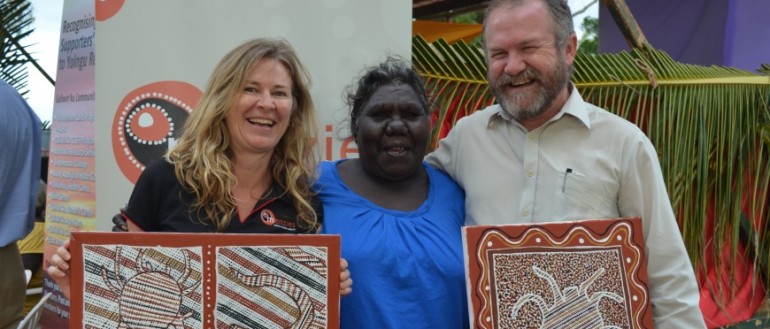Scabies and strongyloides: a community snapshot
Researcher Therese Kearns tests a new treatment for mite and worm infections.
“It itches, throbs, breaks and infects your skin. Sometimes that can expose you to Group A Streptococcal infections, which can lead to heart and kidney disease,” says Therese Kearns.
The nurse, epidemiologist, PhD student and field investigator for the Menzies School of Health Research Scabies and Strongyloides project is explaining the contagious skin disease that affects up to 50 per cent of people in some Indigenous communities.
“Most people infected with scabies get between five to ten mites embedded in their skin,” she says.
Typically, a tropical cream is used to kill the mite. But it‘s cumbersome and hard to administer to groups. It requires all those in a scabies-affected household – sometimes up to 15 people – to lather their whole bodies with the solution, sleep in it and then rinse it off the next morning.
“Some people apply the cream correctly; usually young mums and kids. But not everyone wants to use the treatment,” she says.
Finding solutions: the scabies and strongyloides picture
In a bid to find a more effective solution, Kearns and her colleagues teamed with a remote Northern Australian community in 2009 to workshop alternatives.
One year later, she set about assessing the scene, discovering that four per cent of the community had scabies while 21 per cent had strongyloides – a worm that can migrate through organs in the body, cause diarrhoea in kids, disturb electrolyte levels and suppress energy.
After three months consulting with community members, they together decided on a mass drug administration project using Ivermectin – a tablet that treats both the scabies mite and the strongyloides worm.
The treatment was delivered to 1000 people, and six months later the results looked positive. Strongyloides rates had dropped from 21 per cent to six per cent. Scabies incidence had halved to two per cent.
“The Ivermectin tablets were well accepted by the community,” Kearns says, adding that her experience delivering the treatment gave her a greater insight into the relief, as well as the trauma, that flows from the presence and absence of the disease.
“We witnessed the impact that scabies can have on a whole community. Our story demonstrates how important it is to monitor and protect people with infections – to keep them and their communities scabies-free.”
As for her hopes: “We’d like to see scabies and strongyloides wiped out completely,” Kearns says.
While scabies is endemic in many Aboriginal communities, it’s rarely experienced in other parts of the country. Strongyloides, on the other hand, is commonly seen in migrants from developing countries who are screened and treated when they first arrive in Australia – but it is rarely found in mainstream Australia. Developing countries with overcrowded living conditions also often have high rates of both diseases.
The final results and recommendations from the Menzies’ scabies and strongaloydies project will be published later this year.
Sharing the solutions
“The way we do research projects has changed a great deal,” says Kearns. “People in communities want accredited training that they can use elsewhere. They want skills; they want to be employed.”
To treat scabies, and help to stamp it out, Kearns and her team have learnt the effectiveness of locally-based, medically trained Indigenous workers. “These local workers are vital to help sort out the problems affecting their community,” she says.
As part of Menzies’ Scabies and Strongyloides project, the organisation put 15 community members through a Certificate 2 course in Child Health Research, six through a phlebotomy (blood-taking) course and three through a medication skills assist qualification.
They also organised first aid training with the help of Red Cross, and 60 community members received first aid certificates.
“Our projects are designed to build capacity in communities by providing real qualifications that give people real jobs across a number of different health projects,” Kearns says.

